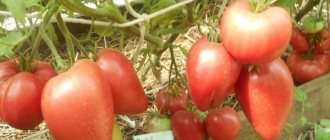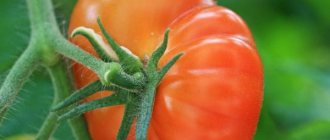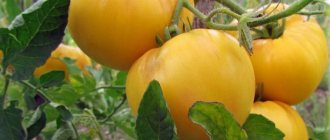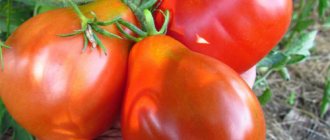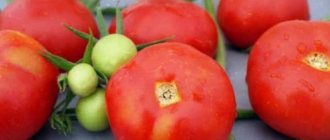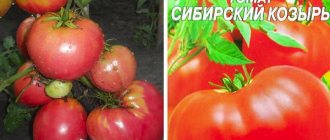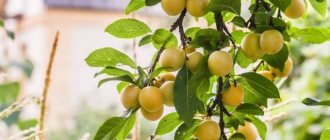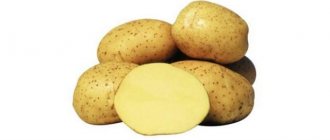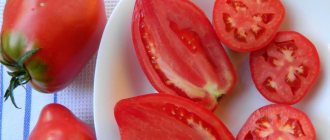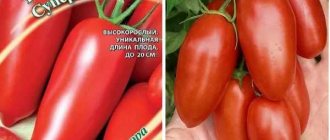Vegetable growing » Tomatoes
0
1299
Article rating
Kira Stoletova
One of the varieties created for cultivation in northern conditions is the Siberian Surprise tomato. Heated greenhouses with a subsoil cushion of fresh manure contribute to the cultivation of rich harvests.
Characteristics of the tomato variety Siberian Surprise
Description
It belongs to the mid-early varieties, ripe fruits appear already on the 101-110th day. The bush is determinate, medium-sized and can reach 120 centimeters in height. The stem is powerful, it is covered with large dark green leaves, the inflorescence is simple, the first is formed above the 10th leaf, the subsequent ones with an interval of 1-2 leaves. Tomatoes grow in clusters, one can contain up to 10 tomatoes.
The fruits are cylindrical, elongated, and resemble peppers. They tie even when weather conditions worsen. Unripe fruits have a light green color, and a dark spot on the stalk; when ripe, they turn red. Weight can range from 80 to 150 grams. The skin is dense, the flesh is fleshy and has a pleasant taste. With the right agricultural technology, you can harvest up to 10 kg of delicious tomatoes from 1 m2.
“Siberian Surprise” is included in the state register of the Russian Federation as suitable for cultivation in open ground and film shelters. It can be eaten fresh, added to various dishes and canned. During processing, the fruits retain their appearance and do not crack.
Advantages
- Versatility of use.
- Tolerates weather changes well.
- Great taste.
- Attractive presentation.
- Easy to care for.
- Subject to storage and transportation.
- Early maturation.
Flaws
- Garter and the need to remove stepsons.
Tomato varieties of Siberian selection (with photos and descriptions)
There are different selections. But among them there is a Siberian one. It is famous for its good varieties. Siberian breeders have bred a very large number of tomatoes, here there are tomatoes with early ripening, and with medium, and very large-fruited, and ordinary, and tall and medium-sized. Each variety is good in its own way. Which ones are the best, what are the characteristics of the variety, where is it better to plant certain seedlings, will be discussed below.
Tomato varieties of Siberian selection with photos and descriptions
Variety "Berdsky large"
Refers to tomatoes with medium and at the same time early ripening periods. The bushes can grow more than 1 meter in length. In order for the harvest to be high, the variety must be constantly shaped and tied up. The best option is two stems. The fruits are large, juicy, orange-red in color. The weight of one tomato can reach up to 800 grams. Suitable for fresh eating and canning. Can be grown both in greenhouses and in open ground.
Variety "Snezhana"
It belongs, like the previous tomato, to varieties with medium and early ripening periods. The first tomato harvests can be obtained 105 days after sowing. A very good tomato, since it does not require special care, can grow both in greenhouses and outdoors. The bush grows compactly, there are few branches and leaves. On average, the height does not exceed half a meter.
Variety "Superbomb"
It produces very large fruits, weighing more than 600 grams. It is better to grow the bush in greenhouses, where it needs to be tied up, since the height of this tall tomato can reach more than one and a half meters. But it will also grow well outside with careful care. Excellent tomatoes, pleasant to taste, do not require much care, aromatic. It is best to form the bush into three stems.
Variety "Samokhval"
The variety has yellow fruits with a pleasant tomato taste. As a rule, their weight is about 300 grams. But if you perform all agricultural techniques as needed, then the fruits can weigh up to 800 grams. A tall bush that requires staking. Grown in any conditions. Productivity and disease resistance are at a high level.
Variety "Barnaul canning"
A sought-after variety that has compact bushes. Gives a good and uniform harvest. From the name it is clear that it is well suited for preservation. The skin does not crack. It can grow in greenhouses, under film, and outside. The fruits ripen early after 100 days on average. Unpretentious.
Variety "Ural Bogatyr"
The powerful bush of these tomatoes can grow more than 2 meters in height. It will need to be shaped and tied to a support. The variety produces good and high-quality harvests. Ripening dates are mid-early.
Variety "Siberian Surprise"
A good variety that produces a stable harvest. The height of the bush reaches up to one and a half meters in height, which indicates that the tomato needs to be tied up. To get the best result, it is better to form this species into three stems. Ripens relatively early. The fruits are red in color and are formed evenly in the form of a brush. One such brush can produce up to 10 tomatoes weighing an average of 140 grams.
Variety "Pink Stella"
Tomatoes of Siberian selection are low-growing. The height of the compact bush does not exceed half a meter. It is noteworthy that the variety does not produce a lot of greenery, and there is no need to plant it. It can grow both indoors and outdoors. The harvest forms in clusters. The color of the fruit is raspberry, weight up to 250 grams. It gives a bountiful harvest, and it is better to tie up the tomatoes so that they do not break under the weight of their own tomatoes.
Variety "Konigsberg"
Refers to tomatoes with medium-early ripening periods. Refers to tall tomatoes. It grows as a long bush that can reach more than two meters in height. Therefore, it must be secured in a support. Stepsonning is also required. The fruits are scarlet in color, weighing up to 300 grams. Suitable for both canning and eating fresh. It is best to form two stems.
Variety "Fidelio"
Ripens early, the yield is high, the purpose is universal. The bush does not grow too tall, up to a maximum of 1.5 meters. It is necessary to remove the stepsons and attach them to the support. It is best to leave two stems. The fruits are large, can reach a weight of up to half a kilogram, and their color is pinkish.
Large-fruited tomatoes of Siberian selection
Variety "Abakan pink"
A good type of tomato that has an average ripening period. The fruits reach a weight of up to half a kilogram. The variety is often compared to “Bull's Heart”. The color of the skin is red, but the flesh is pink. That's why the tomato got its name. The fruits are tasty, juicy, fleshy. Tall bushes up to two meters.
Variety "Grandma's Secret"
A variety with medium ripening periods and very large fruits of more than 1 kg. The color of the skin is scarlet. The bushes are tall, but do not spread out wide. It is better to form them into two stems. The variety is suitable for greenhouse cultivation. They are consumed fresh, in salads, and closed for the winter. The shape of the fruit is flattened and round.
Growing seedlings
Sowing of seeds is usually carried out 60-70 days before the expected date of planting in the soil. For successful cultivation, you must follow the recommended care. And use only proven seeds for sowing; it is better to buy them in specialized stores. Before planting, the seeds are disinfected and then soaked in a stimulant.
The soil is also prepared in advance; before sowing, it is calcined in the oven in order to kill all microorganisms, and then watered with a warm manganese solution. A comfortable temperature for seed germination is considered to be 23-25 degrees. They are sown to a depth of one centimeter, the recommended planting pattern is 3 by 1.5 centimeters.
Picking is mandatory; it is carried out as soon as two true leaves appear on the sprouts. During the growing season, plants need to be fertilized 2-3 times; “Siberian Surprise” responds well to complex fertilizers. If necessary, the plants are illuminated using a fluorescent lamp, it should be 10 cm from the plant. Recommended daylight hours for seedlings are 16 hours. You need to water once every 5 days.
You may be interested in: Dates for planting tomato seedlings in open ground and greenhouses according to the garden calendar Favorable days for planting tomatoes for seedlings in 2021 according to the lunar sowing calendar Favorable days for picking tomatoes in 2021 after germination: timing of picking tomato seedlings in the table by day
Shortly before planting, young plants need to begin to be hardened by taking them out into the air for a short time, in this way they will become stronger and adaptation to a new place will be easier for them.
Tomato care
According to the description, the main components of plant care are:
- constant control of room temperature;
- watering seedlings;
- weeding and loosening;
- fertilizer;
- prevention of viruses and diseases.
When watering, do not pour water on the leaves and stem of the plant.
In greenhouse conditions, a stable temperature is maintained at no lower than 18°C and no higher than 30°C. At low temperatures, plant growth is inhibited, and at high temperatures, flowers and ovaries fall off. The bushes are formed into 2 trunks so that the tomato grows freely. For this they leave the first stepson. All others are deleted. The brush is formed at the level of the 7th leaf.
Tomatoes must be watered abundantly, but not more than 3 times every 10 days. The water should be warm and only fall on the root area. If there is moisture on the leaves, they will begin to rot and crumble.
To ensure that tomatoes receive enough nutrients, they are fertilized. Various chemicals are used. Only wet soil is watered with fertilizers, otherwise there is a risk of chemical burns to the rhizome. Weeding is necessary for plants to get rid of weeds. If they are not there, the soil is loosened after watering. The hard crust that forms on the surface prevents the free circulation of air in the soil. This prevents tomatoes from fully developing and maintaining the harvest.
Prevention and control of diseases
Late blight and gray rot are prevented with Fitosporin. Fundazol protects against the occurrence of fusarium, and the drug Bravo helps against brown spot.
If plants become sick, they are treated immediately. If gray spots and edges appear on the stem and leaves, the plant is being attacked by gray rot. In this case, it is treated with fungicides, which also help fight dry spotting.
When fruits are affected, drugs containing copper or sulfur are used. These can be copper sulfate and colloidal sulfur. Systemic fungicides Fundazol or Kumir help prevent the whitish coating of powdery mildew.
Growing and care
The soil is usually prepared in the fall; for this purpose, humus is added to it and plowed; before planting, it can be treated with warm potassium permanganate, thus disinfecting it. Holes are dug at a distance of 40 cm; from 3 to five bushes can be placed on one square meter. Before transferring young seedlings there, they can be fertilized with wood ash and watered. Since this variety needs staking, pegs are driven in next to the hole, or a trellis is installed for the plants.
After just two weeks, you can fertilize the established bushes; they respond positively to both complex fertilizers and organic ones. Carry out the procedure a second time in a month. Regular watering is recommended, but you should not overwater the plant. Tomatoes love moist and loose soil, so you need to remember to loosen the rows, giving the roots the opportunity to get enough oxygen.
It is best to form bushes with 2-3 stems, this will ensure a higher and more stable yield. Stepchildren need to be cut off weekly. If any signs of disease appear, immediately remove the damaged bush, this will protect the remaining plants from imminent infection.
Agrotechnical techniques
Growing Siberian early ripening tomatoes is best done in fertile soil that has not been depleted by previous crops. In general, this variety is unpretentious to the soil. But experienced gardeners still insist on adhering to the recommendation. Tomatoes can be grown in open or closed ground.
Growing in open ground
The Siberian early ripening tomato is a cold-resistant species. Despite this, it is best not to take risks and grow seedlings in open ground at the age of 50-60 days. In this way we will protect our seedlings from possible frosts. During planting, you need to apply fertilizer, then all that remains is watering.
According to statistics, from 1 square meter you can harvest up to 7 ripe tomatoes. Growing this variety in the garden will bring slightly less yield than in a greenhouse. But this does not at all affect the taste of the fruit. The only thing you need to take care of is protecting the bushes from pests and diseases.
Growing indoors
This type of cultivation focuses on growing seedlings in the greenhouse. You can sow seeds as early as early April. After which comes the period of fertilizing and watering.
As soon as a couple of leaves appear on the seedlings, then it is necessary to dive. In greenhouse conditions, the bush can reach about 1 meter in height. It must be tied to a reliable support, otherwise it may break.
Many gardeners are wondering whether it is necessary to plant the Siberian early ripening variety. Here opinions are divided: some say that stepsoning will be beneficial, others assure that nothing good will happen even if high-quality stepsoning is carried out. Therefore, whether to plant Siberian early-ripening tomatoes or not is entirely up to you to decide.
Growing the Siberian early ripening tomato variety by gardeners has collected a large number of reviews. Naturally, the majority are positive, but there are also neutral ones.
Most often, attention is paid to the high level of yield, taste and resistance to low temperatures. Of course, the most important advantage is growing in any climate zone.
Negative reviews consist only in the fact that this variety is already morally outdated and physically cannot compete with modern hybrids. But this does not at all spoil the description of the tomato and its final result of growing in the form of a good harvest.
Reviews
Yana 30 years old
We live in the Moscow region, we haven’t built a greenhouse yet, and the weather is not always pleasant. I was looking for an unpretentious variety of tomato, and the salesperson in the store advised me to try “Siberian Surprise.” To be honest, I didn’t really believe in success, because last season, on the advice of a friend, I planted a seemingly undemanding variety, but it turned out that either I’m a bad gardener or the variety was not successful. She grew seedlings at home in warmth and comfort, and carefully looked after them. It grew well, I transplanted it into the garden at the beginning of June, surprisingly, the harvest was good, even in cloudy weather the fruits were set. We ate the tomatoes fresh, the taste was excellent, I marinated several jars. Next year I will definitely plant more.
Evgeniy 45 years old
We planted “Siberian Surprise” this season and am pleased with the harvest. Tomatoes are delicious, we ate salads from them all summer. My wife froze it for the winter, used it as a dressing for borscht and added salt. True, I fertilized the plants only twice during the entire period, but nothing bad happened; apparently, it’s not such a demanding variety.
Large-fruited, universal (tomatoes from Siberian Garden)
Distinctive features: unpretentious, high taste.
Bull forehead
A high-yielding variety, one bush can bear up to 9 kg of fruit, the weight of an individual bush is about 600 g.
The color is orange, with a reddish tint.
King of the Giants
From the name it becomes clear what size the fruits are. The height of the bush reaches 170 cm, the weight of the fruit is up to 1 kg.
Resistant to various pests and diseases.
Eagle beak
No, not the same one. This is a completely different variety, although there are still similarities. The shape also resembles the beak of a famous bird.
Height up to 1.5 m, weight reaches 800 g, cultivation is mainly recommended in open ground.
Golden domes
Must be grown in a greenhouse. The color is golden, sometimes more orange. Requires a garter.
Quite a large variety, with a non-distinctive bush size, the weight of the fruit reaches almost a kilogram.
Monastic meal
It has an orange color and is unpretentious to grow. Slightly flattened, roundish shape of the ripe fruit.
If you follow all the nuances of cultivation and high-quality fertilizer, you can achieve a mass of an individual specimen of 400 g.
Goose egg
Carpal variety, distinguished by a good harvest. Reaches up to 2 m, with each tomato weighing up to 300 g.
The color when ripe is dark, pinkish. May also be bright red.
Giant Novikova
It has a very sweet taste and large size.
In individual conditions, with all the nuances observed, the height reaches 2 meters, the weight of one tomato is up to 1 kg.
Novosibirsk hit
Recently developed variety. Physical data does not stand out, the shape is round, red. They perform well when stored in appropriate conditions and when necessary for transportation.
Pros and cons of the variety
The Andreevsky Surprise tomato bears fruit for a long time, as it is resistant to the most common disease - late blight. This allows you to harvest in the greenhouse until autumn.
A small harvest is compensated by excellent taste
pros
- large fruits;
- average yields;
- no wateriness is observed;
- resistance to late blight and other diseases;
- delicate taste due to high sugar content;
- perfectly withstands lack of light.
Minuses
- regular stepsoning is required;
- intolerance to frost (if the temperature drops sharply, the plant dies);
- a garter is required;
- ripe tomatoes may crack;
- vegetables do not tolerate transportation well;
- Due to their large size, not all vegetables can be used for canning.
Advantages and disadvantages of the variety
The Room Surprise tomato has the following advantages:
- early ripeness;
- excellent taste;
- marketable condition;
- possibility of long-term storage of fresh crops;
- good transportability;
- no need for pinching and formation of a tomato bush;
- the ability to grow in any conditions (open ground/greenhouse/greenhouse/balcony/apartment);
- high resistance to common nightshade diseases;
- the ability to keep plants in compacted planting (up to 10 bushes fit per 1 m2 of beds);
- high productivity;
- unpretentiousness (tomatoes easily tolerate lack of moisture and low temperature);
- the ability to collect seed material for sowing seedlings in the future.
Some gardeners include excessive small fruit as a disadvantage of the variety. Small fruits are convenient to salt and pickle, but for canning, fruits weighing 50–60 g are more often used, while the bulk of Room Surprise tomatoes does not exceed 20–30 g.
In addition, the yield of this tomato greatly depends on its care. So, with infrequent watering and lack of fertilizing, the yield will not be high.
Table: comparison of Room Surprise with other similar varieties of tomatoes
| Variety name | Ripening time | Purpose | Average fruit weight, g | Marketable yield, kg/sq. m | Growing regions | Growing conditions |
| Room surprise | Early ripening | Salad | 25 | 2,5–2,9 | All regions of Russia |
|
| Balcony miracle | Mid-season | Universal | 30–40 | 5–6 |
| |
| Garden pearl | Early ripening | Salad | 15–20 | 4,8 |
| |
| Florida Petite | 20–25 | 5 | ||||
| Krakowiak | Very early | 70–80 | 5–6 | |||
| Honey bunch | 40 | 5 |
How to grow seedlings yourself
Seeds are planted in boxes with special soil at the end of March. The soil is prepared before sowing the seed 14 days before the procedure. If there is no purchased soil, then it is made from a mixture of humus, earth and sand. The finished soil is disinfected with a strong solution of potassium permanganate, and then filled with suitable containers.
Before planting in the ground, seeds are treated with potassium permanganate or aloe juice. The soil is well moistened, and then the seeds are sown in boxes to a depth of 20 mm.
The container is placed in a warm place and covered with film. When the soil dries out, moisten it with a watering can or spray bottle.
After 4 days the first shoots will appear. They practically do not need additional lighting. Boxes with seedlings are placed on the windowsill. After 1-2 leaves appear, the seedlings dive.
The day before this procedure, it is recommended to water the bushes abundantly. Then the sprouts, together with lumps of earth, are transplanted into separate pots. Their diameter should not exceed 10 cm.
To eliminate the risk of fungal infection, seedlings are treated with a weak solution of potassium permanganate.
Feeding of seedlings is carried out 7-10 days after diving, and then the operation is repeated once a week. Manure or herbal infusions are used as fertilizer.
When the seedlings are 60 days old, they are hardened off and then transplanted to permanent beds.
The soil in the greenhouse must be well heated. Manure is introduced into it, and the fertilizer is covered with a layer of soil from 16 to 18 cm on top. A layer of wood ash is poured between the soil and manure. The scheme for planting young bushes in a greenhouse is 0.6x0.4 m. Transplantation is carried out in cloudy weather in the evening.
Before this, it is recommended to install strong supports (stakes) to which the plants should be tied after planting in the ground.
Pest and disease control
The Andreevsky Surprise variety is resistant to common tomato diseases; they can develop against the backdrop of unfavorable conditions.
Only healthy, strong plants with good immunity can provide the greatest resistance to infections.
The most dangerous and common are two diseases for the St. Andrew's surprise tomato.
- Mosaic. Tomatoes cannot be cured; the affected bush is removed and burned. For prevention, seeds and soil are disinfected. They also use spraying the solution with milk (1 teaspoon of urea is added to a bucket of water, where 1 liter of milk is diluted).
- Late blight. For prevention, use the drug “Profit Gold”, an iodine solution (1 tsp of the substance per bucket of water).
Tomato hybrid Indoor surprise brief description
The complete opposite of the variety described above is the hybrid tomato variety Room Surprise (second name Balcony Surprise). This is a low-growing tomato intended for home growing. This hybrid is also often used for rack (tiered) cultivation in greenhouses - on the top shelves. Its fruits are very tasty and beautiful, and are in high demand in markets and for restaurant cuisine.
- The bush is low-growing, no more than 50 cm in height.
- The stem is strong and can be grown without support - then it lies on the ground or hangs from a flowerpot. But still, it is better to make the simplest support for the plant - a bush hung with bright tassels, very decorative.
- Vegetable growers claim that the hybrid behaves like a perennial plant - after replanting, radical pruning and renewal, it again begins to grow and yield.
- There is no point in collecting seeds, varietal characteristics are not preserved, but the hybrid is easily propagated by cuttings - the shoots are rooted in water and planted as seedlings.
- The hybrid almost never gets sick! Resistant to all types of nightshade diseases.
- The variety is self-pollinating and does not require insects, which is convenient for the home. There are 6-8-10 ovaries in the cluster, maturation begins from the stem.
Room surprise tomato tomatoes, according to photos and reviews, are very attractive, bright red, oval in shape, even in size, very tasty, sweet with a slight sourness, weight 50 g, dense flesh. Used in salads and for drying, for preparations in general.
Caring for the Indoor Surprise tomato is the same as for other potted varieties: you can sow directly into flowerpots, the volume is at least 5 liters, no shaping or pinching is required. But if you leave 3-4 stems, the tomatoes will be larger.
Marianna Pavley

